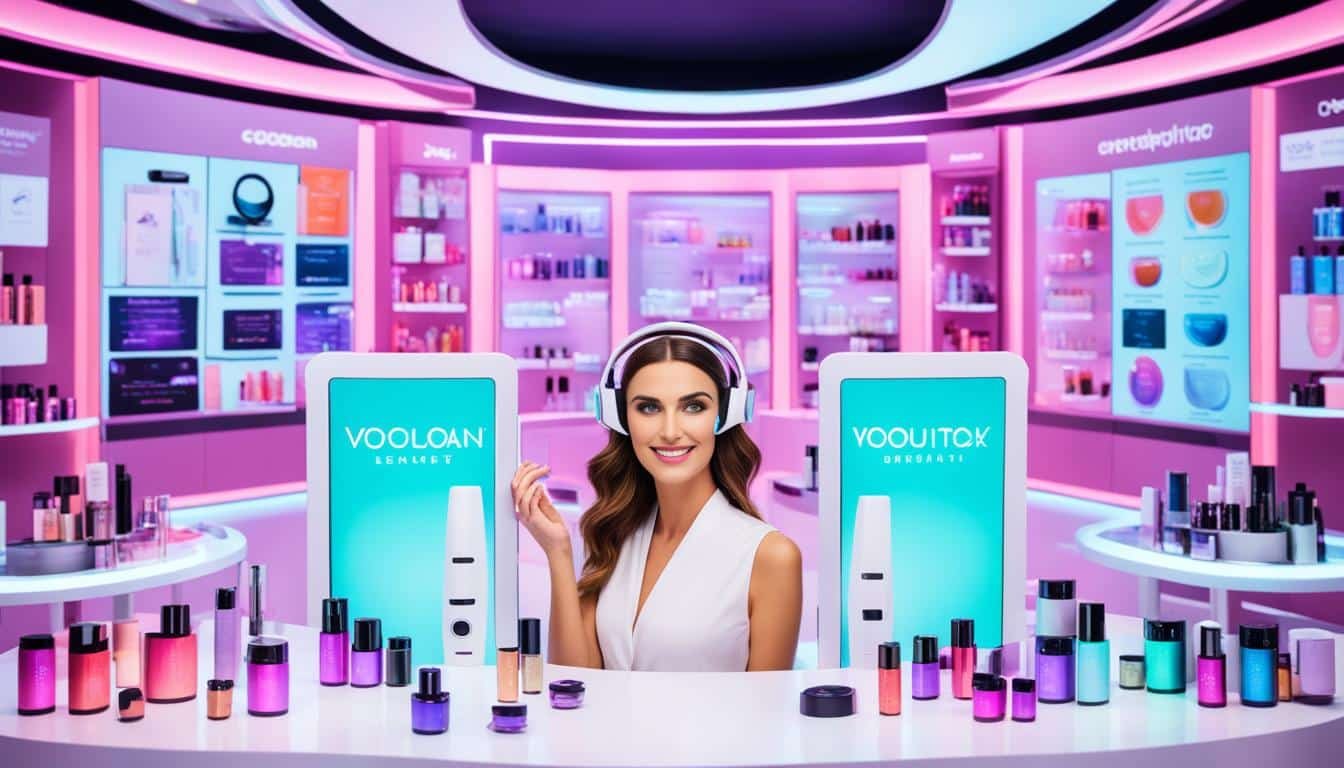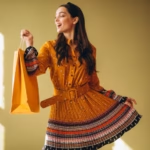Fresh Trends In Beauty Shopping : The beauty industry is constantly evolving, and staying up-to-date with the latest trends is essential for beauty shoppers. As the market research predicts, the beauty and personal care industry will exceed $101 billion in revenue by 2027, showcasing the immense opportunities and growth potential in this sector.
A key trend in the beauty shopping industry is the demand for personalized experiences. Today, 71% of shoppers expect a personalized experience when they shop, highlighting the importance of catering to individual needs and preferences. To meet these expectations, brands are utilizing hyper-personalization techniques with Artificial Intelligence (AI) and Augmented Reality (AR) to offer virtual try-on experiences and personalized beauty recommendations. This immersive and engaging approach not only enhances the shopping experience but also helps shoppers make more informed purchasing decisions.
Another significant trend shaping the beauty industry is the focus on sustainability. Consumers are increasingly seeking brands that prioritize eco-friendly practices and use natural and organic ingredients. In fact, more than 65% of consumers actively seek out environmentally friendly brands, with 55% willing to pay a premium for sustainable products. Beauty brands are incorporating biotech innovations to develop sustainable ingredients in skincare and haircare products. By utilizing biotechnology, brands can create ingredients that are both effective and environmentally conscious, satisfying the growing demand for sustainable beauty options.
Moreover, influencer marketing remains a powerful strategy for beauty brands to reach their target audience. Social media platforms like TikTok and Instagram play a crucial role in driving brand engagement and sales. Beauty influencers, especially micro-influencers, provide relatable and authentic content that resonates with their followers, resulting in higher engagement and interest in beauty products. Collaborating with influencers allows brands to leverage their influence and expand their reach in a meaningful way.
Key Takeaways:
- Hyper-personalization with AI and AR is a top trend in the beauty industry, offering virtual try-on experiences and personalized recommendations.
- Biotech innovations focusing on sustainability are shaping the industry, with brands utilizing environmentally friendly ingredients.
- Natural and organic ingredients are in high demand as consumers look for eco-friendly and sustainable beauty products.
- Influencer marketing on TikTok and Instagram drives engagement and sales for beauty brands.
- The beauty industry is constantly evolving, and brands that adapt to these trends will thrive in the competitive market.
Hyper-Personalization with AI and AR
Hyper-personalization with artificial intelligence (AI) and augmented reality (AR) is revolutionizing the beauty industry. As consumer expectations for personalized experiences continue to rise, brands are leveraging the power of AI and AR to create immersive and tailored shopping experiences.
Research has shown that 71% of consumers now expect a personalized experience when they shop. This demand has led to the integration of high-tech solutions like AI skincare advisors and AR makeup try-on experiences. With AI, beauty brands can analyze individual preferences, skin types, and concerns to offer personalized product recommendations and custom skincare formulas.
The use of AR technology allows consumers to try out beauty products virtually, eliminating the need for physical testing. Virtual reality and AI experiences provide a sense of confidence in purchasing, as customers can see how products will look on them before making a purchase.
One popular application of AI and AR in the beauty industry is the use of online quizzes. By taking a quiz, consumers can answer questions about their skin type, concerns, and preferences to receive personalized beauty product recommendations. According to recent studies, 58% of beauty shoppers are more likely to buy from a business that offers an online quiz.
“[Virtual reality and AI experiences] decrease the barrier between trying and buying, ultimately leading to higher conversion rates and brand loyalty,” says Emily Johnson, a beauty industry expert.
Benefits of Hyper-Personalization with AI and AR:
- Enhanced customer satisfaction and loyalty
- Reduced return rates by allowing virtual try-ons
- Improved engagement and conversion rates
- Increased brand trust and authenticity
Beauty brands are continuously investing in AI and AR technologies to provide a personalized and seamless shopping experience for their customers. As consumer preferences evolve, staying ahead of the curve and leveraging these technologies will be crucial for beauty brands to succeed in the competitive market.
Biotech Innovations with a Focus on Sustainability
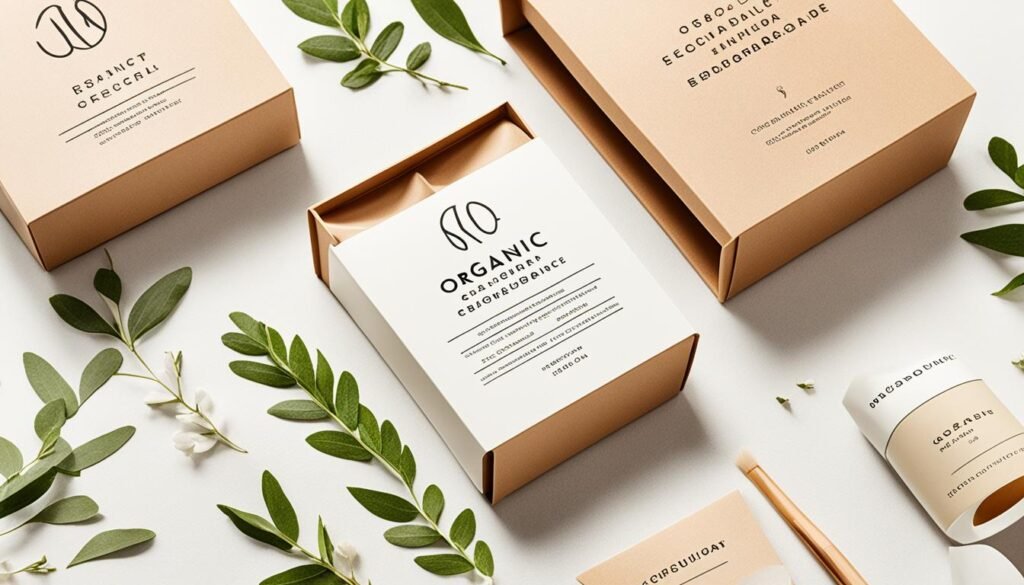
The beauty industry is embracing biotech innovations with a focus on sustainability. Brands are harnessing the power of biotechnology to replicate natural ingredients found in organisms, allowing for mass production of sustainable beauty ingredients. These advancements not only lead to eco-conscious formulations but also contribute to the preservation of biodiversity.
One notable example of biotech innovation is Algenist, a skincare brand that has developed a patented ingredient called Alguronic Acid. Alguronic Acid is derived from microscopic algae and is proven to improve overall skin health while reducing the appearance of fine lines and wrinkles. This biotechnological breakthrough offers consumers an effective and sustainable alternative to traditional anti-aging ingredients.
Alguronic Acid represents a significant advancement in sustainable skincare. Its unique properties are a testament to the potential of biotech innovations in meeting the growing demand for both efficacy and environmental responsibility in the beauty industry.
Another brand utilizing biotech research is Evolved By Nature. They have created a sustainable compound called Activated Silk, made from renewably-sourced silk protein. This innovative ingredient serves as a replacement for petroleum-based ingredients commonly found in beauty products. By opting for Activated Silk, beauty brands prioritize environmental sustainability without compromising on quality or performance.
In addition to developing sustainable ingredients, the beauty industry is also focusing on sustainable packaging to minimize waste and reduce its environmental impact. By adopting eco-friendly packaging materials and designing innovative packaging solutions, brands demonstrate their commitment to sustainability and cater to the increasing consumer demand for environmentally responsible products.
Biotech Innovations in Sustainable Beauty
| Brand | Innovation |
|---|---|
| Algenist | Alguronic Acid – derived from microscopic algae, improves skin health |
| Evolved By Nature | Activated Silk – made from renewably-sourced silk protein, a sustainable alternative to petroleum-based ingredients |
Natural and Organic Ingredients
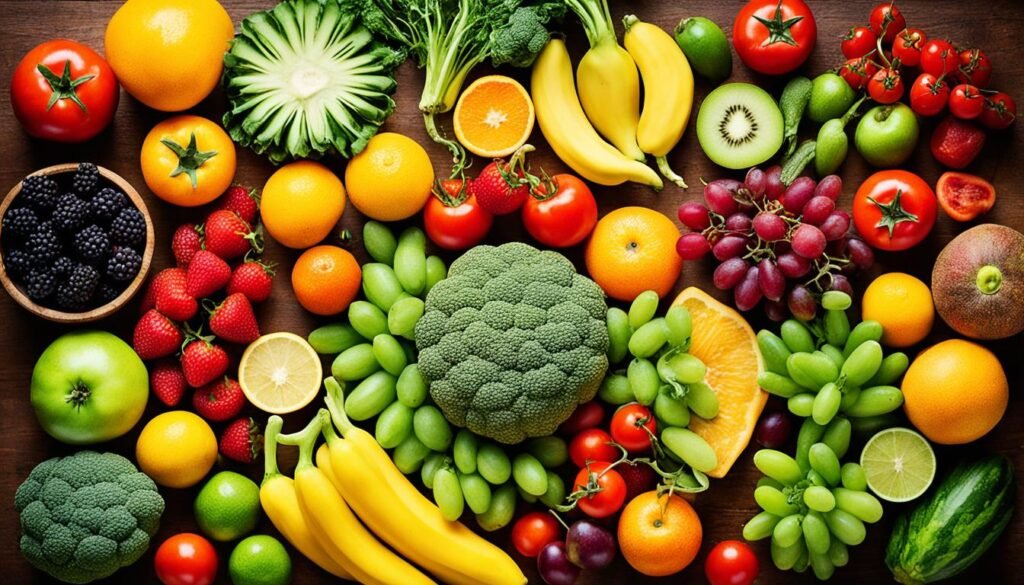
Consumers are increasingly seeking beauty products that contain natural and organic ingredients. In fact, a survey shows that over 65% of consumers actively look for environmentally friendly brands, and 55% are willing to pay more for sustainable products. With the market value for natural beauty and cosmetics expected to reach $59 billion by 2031, it’s clear that the demand for clean and natural beauty products is growing rapidly.
Recognizing this trend, many beauty brands are embracing sustainability and creating products that are both natural and organic. One such brand is Walmart, which has recently launched a clean beauty shop offering products free from harmful ingredients. By eliminating harmful chemicals and using sustainable sourcing methods, these brands are not only meeting consumer demand but also contributing to a healthier planet.
When it comes to sustainable beauty, the use of natural and organic ingredients is key. These ingredients are derived from renewable resources and are biodegradable, minimizing their impact on the environment. They are also free from synthetic chemicals, making them safer for our bodies and overall well-being. Brands that prioritize natural and organic ingredients are not only promoting cleaner beauty practices but also setting a higher standard for the industry as a whole.
Benefits of Natural and Organic Ingredients:
- Healthier for the skin: Natural and organic ingredients are gentle on the skin, reducing the risk of irritation and allergic reactions.
- Environmental sustainability: By using natural and organic ingredients, brands contribute to a more sustainable and eco-friendly beauty industry.
- Improved skin benefits: Many natural ingredients have additional skin benefits such as hydration, anti-aging properties, and antioxidant protection.
- High-quality formulations: Brands that prioritize natural and organic ingredients often invest in research and development to create effective and innovative formulations.
- Transparency: With natural and organic ingredients, brands can provide greater transparency to consumers, helping them make informed choices about the products they use.
Embracing natural and organic ingredients is an important step towards sustainable beauty. By choosing products that are free from harmful chemicals and made with environmentally friendly practices, consumers can not only enhance their beauty routine but also contribute to a greener future.
“The use of natural and organic ingredients is not just a trend, but a necessary shift towards a healthier and more sustainable beauty industry.”
| Benefits of Natural and Organic Ingredients | Percentage of Consumers |
|---|---|
| Healthier for the skin | 82% |
| Environmental sustainability | 76% |
| Improved skin benefits | 89% |
| High-quality formulations | 78% |
| Transparency | 85% |
Beauty Sales and Brand Engagement on TikTok and Instagram
Social media platforms have revolutionized the beauty industry, providing new opportunities for sales and brand engagement. In particular, TikTok and Instagram have emerged as popular channels for beauty enthusiasts to discover and purchase their favorite products. With their visual nature and vast user base, these platforms have become powerful tools for beauty brands to connect with their target audience.
According to recent studies, nearly half of social media users are projected to make at least one beauty purchase on a social platform. Moreover, the average shopper on social media spends approximately $800 on social commerce each year. This indicates the immense potential for beauty brands to tap into this growing market.
Both TikTok and Instagram wield significant influence over beauty purchasing decisions. In fact, a staggering 60% of users have admitted to making a beauty purchase after seeing a product on social media. This highlights the importance of leveraging these platforms to drive brand awareness and increase sales.
One of the key strategies employed by beauty brands on TikTok and Instagram is collaborating with beauty influencers. These influencers, with their loyal following and expertise in the beauty industry, allow brands to connect with their target audience in an authentic and relatable way. By featuring products in their content, influencers can effectively drive engagement and spark interest among their followers.
Another crucial aspect of brand engagement on these platforms is user-generated content. When users create their own content featuring a brand’s products, it not only generates buzz but also fosters a sense of community. By encouraging and sharing user-generated content, beauty brands can strengthen their relationship with their customers and build loyalty.
Social commerce is continually evolving, and as beauty brands continue to explore the potential of platforms like TikTok and Instagram, they must adapt to the changing landscape. Engaging with beauty influencers and harnessing the power of user-generated content are essential strategies for brands looking to thrive in the dynamic world of social media. By leveraging these platforms effectively, beauty brands can maximize their reach, boost sales, and build lasting connections with their target audience.
Beauty Influencer Engagements on TikTok and Instagram
As mentioned earlier, collaborating with beauty influencers is a key strategy for driving brand engagement on TikTok and Instagram. These influencers have a significant impact on their followers’ purchasing decisions and can effectively amplify a brand’s message. By partnering with influencers who align with their target audience’s interests and values, beauty brands can create authentic and relatable content that resonates with their customers.
| Influencer Name | Platform | Followers | Engagement Rate |
|---|---|---|---|
| BeautyGuru21 | TikTok | 3.2 million | 6.8% |
| GlamQueen | 1.5 million | 4.2% | |
| MakeupJunkie | TikTok | 2.8 million | 7.1% |
| BeautyByNature | 2.1 million | 5.5% |
“Collaborating with influencers has been incredibly beneficial for our brand. Their genuine love for our products shines through their content, and it has significantly increased brand engagement and sales.” – Beauty Brand CEO
These statistics highlight the potential reach and impact that beauty influencers possess. Their ability to engage their followers and drive product discovery is unparalleled, making influencer partnerships an integral part of brand strategies on TikTok and Instagram.
The Beauty Industry’s Growth and Competitive Landscape
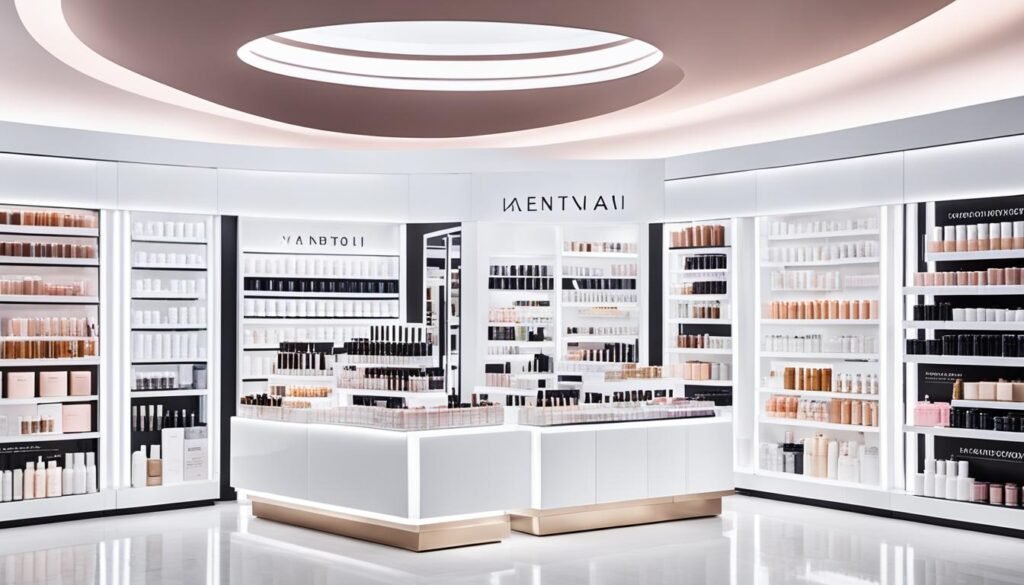
The beauty industry is witnessing remarkable growth, particularly in the e-commerce sector. Online sales are projected to reach a staggering $440 billion within the next five years, a substantial increase compared to the $110 billion recorded in 2015. As consumers increasingly embrace digital channels for their beauty needs, e-commerce currently accounts for over 20% of total beauty product sales.
However, growth is not limited to online platforms alone. Traditional retailers, such as department stores, are expected to regain momentum post-pandemic, attracting customers with their in-store experiences and personalized services. By adopting an omnichannel approach, beauty brands can complement their online presence with brick-and-mortar establishments, catering to the diverse preferences of consumers.
Geographical diversification plays a vital role in the beauty industry, with China and the United States remaining as dominant markets. Simultaneously, emerging regions like the Middle East and India present exciting opportunities for market expansion. By tapping into these new markets, beauty brands can capitalize on a larger consumer base and diversify their revenue streams.
Furthermore, the luxury beauty segment is expected to double in size, indicating substantial growth prospects for high-end beauty brands. With consumers increasingly pursuing premium beauty products and services, luxury brands have an opportunity to capture a larger share of the market through innovative offerings and exclusive experiences.
Comparison of Beauty Industry Growth and Market Opportunities
| Key Factors | E-commerce Beauty | Department Stores | Geographical Diversification | Luxury Beauty |
|---|---|---|---|---|
| Market Growth | Rapidly increasing sales, projected to reach $440 billion in five years | Anticipating a resurgence in post-pandemic era | Opportunities in emerging markets like the Middle East and India | Expected to double in size, catering to the demand for premium products |
| Competition | Fierce competition in the online space, requiring differentiation and personalized experiences | Competing with online platforms by providing unique in-store experiences | Establishing a strong presence in diverse regions, adapting to local preferences | Competition among luxury brands intensifies with a focus on exclusivity |
| Omnichannel Shopping | Offering convenience and personalization through a seamless online shopping experience | Fusing online and offline channels to provide a holistic shopping journey | Expanding operations to new markets, ensuring a cohesive omnichannel presence | Creating a sense of exclusivity and luxury through multi-channel touchpoints |
| Market Share | Reshaping the beauty landscape, accounting for over 20% of total beauty sales | Potential market rebound post-pandemic, competing with online giants | New markets present opportunities to capture a larger consumer base | Sustained demand for luxury beauty products, driving market share expansion |
The beauty industry is poised for growth, presenting both opportunities and challenges for brands operating in this competitive landscape. By strategically navigating the e-commerce boom, leveraging omnichannel shopping experiences, thriving in diverse geographical markets, and capturing the luxury beauty segment, brands can position themselves for success in this ever-evolving industry.
Five Disruptive Themes in the Beauty Industry
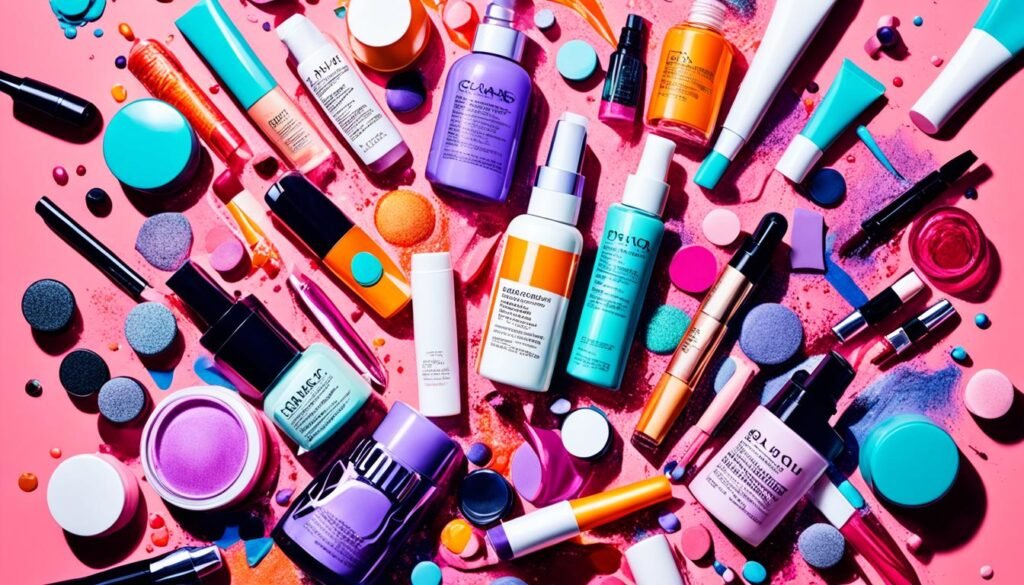
The beauty industry is experiencing several disruptive themes that will shape its future. Let’s explore five key themes that are driving change in the industry:
Growth Map: Shift from China to the United States
The growth map of the beauty industry is undergoing a shift, with the United States emerging as a significant growth engine. While China has historically dominated the beauty market, the US market is witnessing rapid expansion and presents lucrative opportunities for brands.
Wellness: Blurring the Lines Between Beauty and Self-Care
The rise of wellness is transforming the beauty industry, blurring the lines between beauty and self-care. Consumers are seeking products that not only enhance their appearance but also promote overall well-being. Brands that tap into the wellness trend and offer products aligned with self-care are positioning themselves for success.
Gen Z: Sustainability and Authenticity
Gen Z, the generation known for its values-driven mindset, is making a significant impact on the beauty industry. With a strong focus on sustainability and authenticity, Gen Z consumers are demanding more from beauty brands. Brands that prioritize sustainable practices and foster genuine connections with this influential group can gain a competitive edge in the market.
Scaling: A Challenge for New and Independent Brands
Scaling poses a significant challenge for many new and independent beauty brands. While some experience initial success, few can sustain significant growth. Overcoming barriers to scaling requires strategic planning, strong branding, and effective marketing strategies.
Mergers and Acquisitions (M&A): Driving Industry Consolidation
Mergers and acquisitions (M&A) play a vital role in the beauty industry, driving industry consolidation and fostering growth opportunities. Brands and investors are actively seeking opportunities to acquire promising beauty companies, leveraging synergies and expanding market presence.
| Theme | Key Takeaways |
|---|---|
| Growth Map | The United States is becoming a significant growth engine in the beauty industry, challenging China’s dominance. |
| Wellness | The rise of wellness blurs the lines between beauty and self-care, creating opportunities for brands. |
| Gen Z | Gen Z’s focus on sustainability and authenticity is influencing the industry and shaping consumer expectations. |
| Scaling | Scaling is a challenge for many new and independent beauty brands, requiring strategic planning and strong branding. |
| Mergers and Acquisitions | M&A activity drives industry consolidation and provides growth opportunities for brands and investors. |
Influencer Marketing
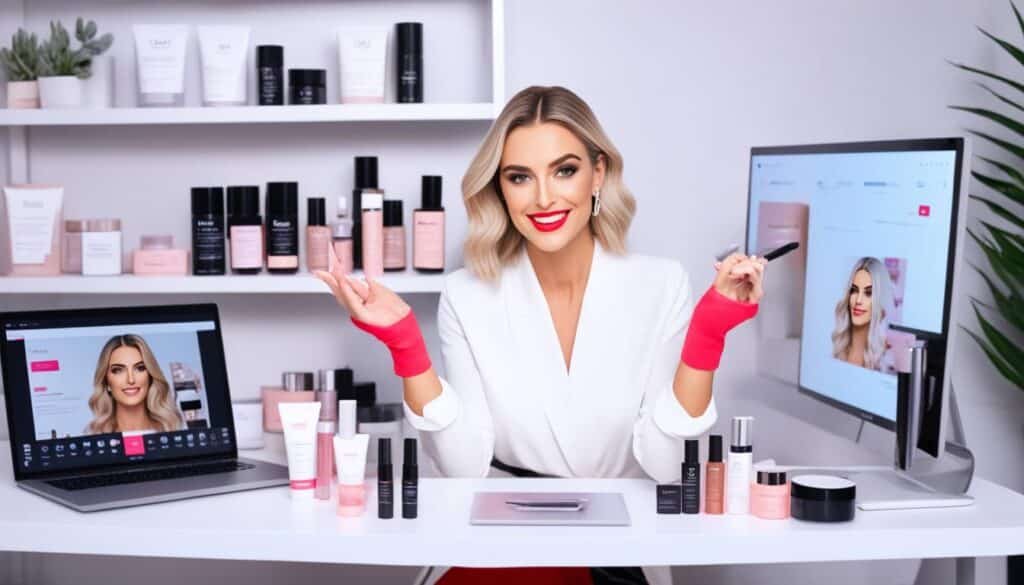
Influencer marketing plays a pivotal role in the beauty industry, harnessing the power of social media influencers to drive engagement and sales for beauty brands. While celebrities have traditionally been the preferred choice for endorsements, the trend has shifted towards micro-influencers. These individuals offer relatability and authenticity, making them more capable of connecting with their target audience. Collaborating with beauty-focused micro-influencers has proven to yield higher engagement and interest from followers who genuinely share an affinity for beauty products.
Successful beauty brands have recognized the potential of influencer partnerships on popular platforms like Instagram and TikTok. By leveraging the creative influence of these social media personalities, brands can generate brand awareness and reach new customers who trust and value the opinions of their favorite influencers. In fact, a survey found that nearly 60% of users make beauty purchases after seeing a product on social media. The impact of influencer endorsements and user-generated content cannot be underestimated, as they have the potential to significantly impact sales and brand growth.
Authenticity and Engagement
The rise of micro-influencers in the beauty industry can be attributed to their ability to foster authenticity and engagement. Unlike celebrities, micro-influencers often have a smaller, highly engaged following. This allows them to develop a genuine connection with their audience, which translates into more meaningful interactions. Beauty-focused micro-influencers share their personal experiences, provide honest product reviews, and engage in conversations with their followers, creating a sense of trust and credibility. Consequently, when micro-influencers recommend beauty products, their audience is more likely to take these recommendations seriously and make corresponding purchases.
The rise of micro-influencers in the beauty industry can be attributed to their ability to foster authenticity and engagement.
In addition to their relatability, micro-influencers offer a more cost-effective approach to influencer marketing. Collaborating with micro-influencers typically involves more reasonable rates or sometimes even product exchanges, making it an attractive option for beauty brands with limited marketing budgets.
Building Relationships through Partnerships
Beauty brands are increasingly adopting influencer partnerships as an essential component of their marketing strategy. These partnerships go beyond one-off sponsored posts and focus on building long-term relationships with influencers. By establishing ongoing collaborations, beauty brands can tap into the influencer’s loyal audience and maintain a consistent brand presence in their content. This approach ensures that the brand is continuously exposed to potential customers who trust the influencer’s recommendations.
Furthermore, influencer partnerships offer opportunities for co-creation and the development of unique campaigns. Collaborative projects not only showcase the influencer as an advocate for the brand but also provide an engaging and interactive experience for their followers. This form of influencer marketing adds depth to the brand’s messaging and fosters a deeper connection with the audience.
In summary, influencer marketing is a powerful strategy in the beauty industry, enabling brands to drive engagement and sales. By leveraging the relatability and authenticity of micro-influencers, beauty brands can connect with their target audience on a more personal level. Collaborative partnerships and the use of user-generated content establish trust and credibility, ultimately resulting in increased brand awareness and growth.
Augmented Reality (AR)
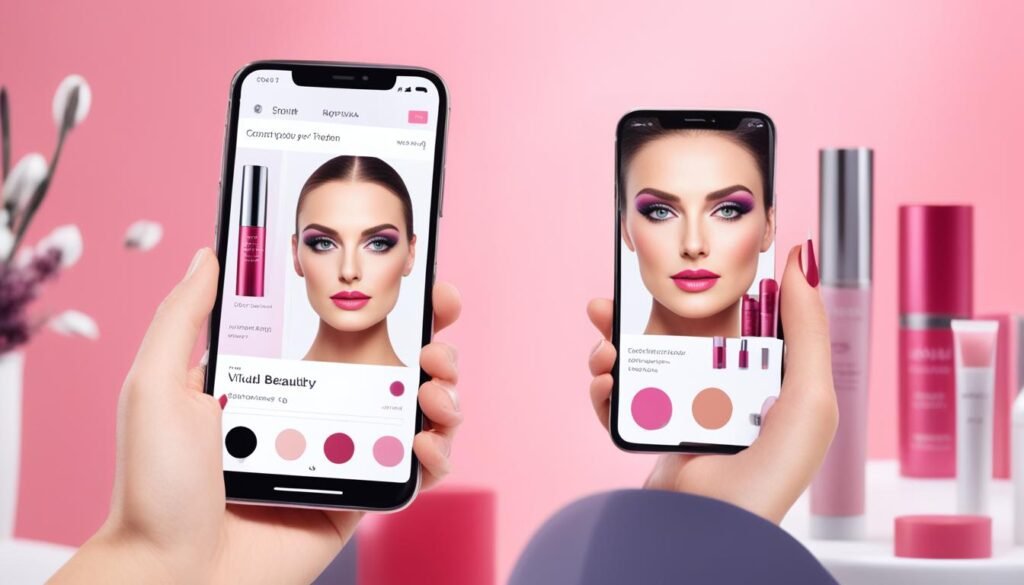
Augmented Reality (AR) is revolutionizing the beauty shopping experience by allowing customers to virtually try on products before making a purchase. With the challenge of online shopping where customers cannot physically test products, AR technology provides a solution that enhances the shopping process. By offering virtual try-on features, beauty brands can significantly increase customer confidence in purchasing, reduce return rates, and provide a frictionless shopping experience.
Leading beauty brand Lancome, for example, offers advanced AR tools that enable customers to try on different shades of lipstick and foundation. Using live camera or uploaded photos, customers can effortlessly visualize how these products would look on them without the need for a physical try-on.
AR technology is a game-changer in the beauty industry. It enhances the customer experience by making online shopping more interactive and immersive. With virtual try-on capabilities, customers can explore different beauty looks and experiment with products before making a purchase, ultimately leading to higher customer satisfaction and engagement.
Sustainability
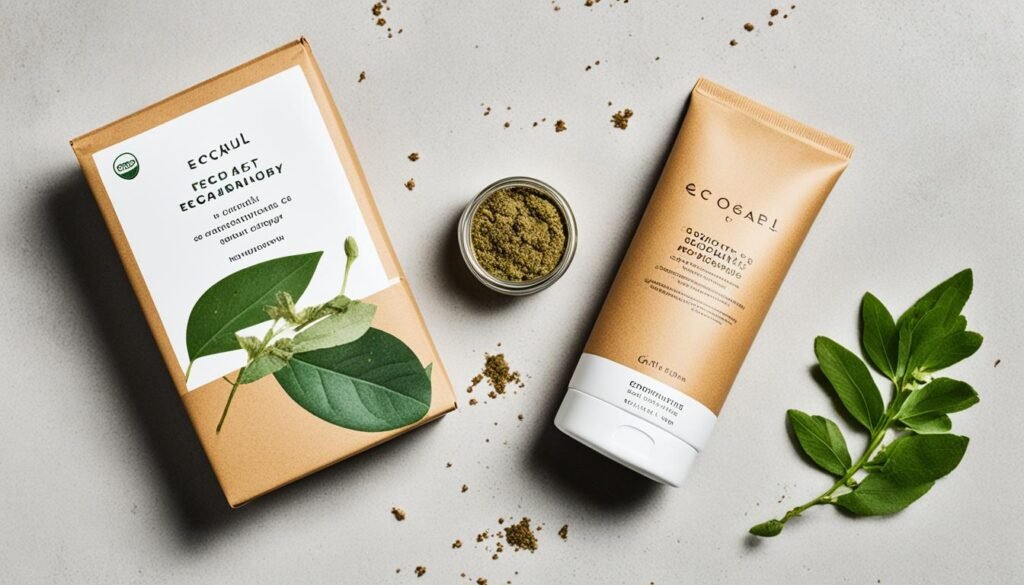
Sustainability is a key focus for the beauty industry, as brands recognize the importance of reducing waste and environmental impact. Many beauty companies are investing in sustainable packaging to minimize plastic waste.
According to a recent GCI study, consumer demand for sustainable packaging is on the rise, with 60% of US consumers considering sustainability a factor in their beauty purchases.
“Sustainability isn’t just a buzzword, it’s a necessity in today’s beauty landscape. Consumers, especially younger generations, are increasingly concerned about the environmental impact of their choices. By embracing sustainable packaging, beauty brands can align with customer values and contribute to a greener future.”
Authentic sustainability initiatives are driving consumer loyalty, with 15% of shoppers prioritizing sustainability efforts over pricing. Brands that genuinely prioritize sustainability and communicate their efforts transparently can establish a stronger connection with their customers.
The Role of Environmentally-Friendly Fulfillment
Sustainability goes beyond packaging and extends to the entire supply chain, including fulfillment. Implementing environmentally-friendly fulfillment practices, such as optimizing transportation routes and using eco-friendly packaging materials, further reduces the carbon footprint of beauty brands.
Consumers are increasingly seeking brands that align with their own sustainability values and prioritize authenticity. By embracing sustainable practices throughout their operations, beauty brands not only support a healthier planet but also attract and retain customers who value eco-friendly initiatives.
Beauty brands are investing in sustainable packaging to reduce waste and environmental impact
Conclusion
The beauty shopping landscape is constantly evolving, driven by consumer demands and technological advancements. The top trends shaping the beauty industry include hyper-personalization with AI and AR, biotech innovations with a focus on sustainability, natural and organic ingredients, influencer marketing, augmented reality, a focus on self-care, subscription boxes, social commerce, sustainability, loyalty programs, and expanding omnichannel offerings.
Brands that stay ahead of these trends and offer personalized experiences, sustainable products, and engaging social media strategies will thrive in the competitive beauty market. With a growing market and changing consumer preferences, the future of the beauty shopping experience is exciting and full of opportunities for brands to connect with their target audience.
As beauty shoppers increasingly seek personalized experiences and sustainable options, brands that prioritize hyper-personalization with AI and AR, invest in biotech innovations for sustainable ingredients, and focus on natural and organic products will be well-positioned for success. Influencer marketing and augmented reality technologies provide unique opportunities to engage and convert customers. Additionally, brands that embrace social commerce, loyalty programs, and omnichannel strategies can maximize their reach and create a seamless shopping experience.
Overall, the beauty industry is constantly evolving to meet consumer demands, and brands that adapt to these trends will not only survive but thrive in the competitive landscape. By staying ahead of the curve and embracing the changing dynamics of the beauty shopping experience, brands can connect with their target audience and secure a strong position in the market.
Also Refer : Expert Shopping Tips For Busy Moms
FAQs
What are the fresh trends in beauty shopping?
The fresh trends in beauty shopping include hyper-personalization with AI and AR, biotech innovations with a focus on sustainability, a demand for natural and organic ingredients, influencer marketing, augmented reality, a focus on self-care, subscription boxes, social commerce, sustainability, loyalty programs, and expanding omnichannel offerings.
How can AI and AR enhance the beauty shopping experience?
AI and AR can enhance the beauty shopping experience by providing virtual try-on experiences, personalized beauty recommendations, and custom skincare formulas. These technologies allow customers to virtually test products before purchasing, increasing confidence and reducing return rates.
How are brands implementing sustainability in the beauty industry?
Brands are implementing sustainability in the beauty industry by using biotechnology to create sustainable ingredients, such as Alguronic Acid and Activated Silk. They are also focusing on sustainable packaging to reduce waste and environmental impact.
What are consumers looking for in beauty products?
Consumers are looking for natural and organic ingredients in beauty products. They are also seeking environmentally friendly brands and are willing to pay more for sustainable products.
How do TikTok and Instagram influence beauty sales?
TikTok and Instagram have a significant impact on beauty sales, with nearly 60% of users making a beauty purchase after seeing a product on social media. User-generated content and influencer partnerships play a major role in driving sales on these platforms.
What is the growth outlook for the beauty industry?
The beauty industry is experiencing significant growth in the e-commerce sector, with online sales projected to reach $440 billion in the next five years. Traditional retailers like department stores are also expected to pick up post-pandemic. China and the United States remain dominant markets, but new potential markets like the Middle East and India are emerging.
What are the disruptive themes shaping the beauty industry?
The disruptive themes shaping the beauty industry include a shift in growth from China to the United States, the rise of wellness blurring the lines between beauty and self-care, the influence of Gen Z on sustainability and authenticity, scaling challenges for new brands, and mergers and acquisitions playing a major role in industry growth.
How effective is influencer marketing in the beauty industry?
Influencer marketing is highly effective in the beauty industry, with social media influencers driving engagement and sales for beauty brands. Partnering with micro-influencers has been shown to generate higher engagement and interest from followers who are genuinely interested in beauty products.
How does augmented reality (AR) improve the beauty shopping experience?
Augmented reality allows customers to virtually try on beauty products before making a purchase, addressing the challenge of online shopping where customers cannot physically test products. AR technology increases customer confidence, reduces return rates, and provides a frictionless shopping experience.
How are beauty brands embracing sustainability?
Beauty brands are embracing sustainability by investing in sustainable packaging to minimize plastic waste and by creating environmentally friendly fulfillment practices. Consumers prioritize brands with authentic sustainability initiatives.
What are the key trends shaping the beauty shopping industry?
The key trends shaping the beauty shopping industry include hyper-personalization, biotech innovations, natural and organic ingredients, influencer marketing, augmented reality, social commerce, sustainability, loyalty programs, and expanding omnichannel offerings.
